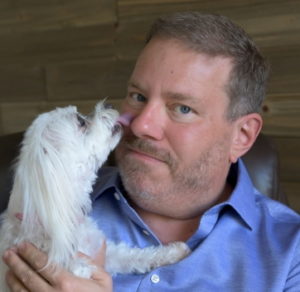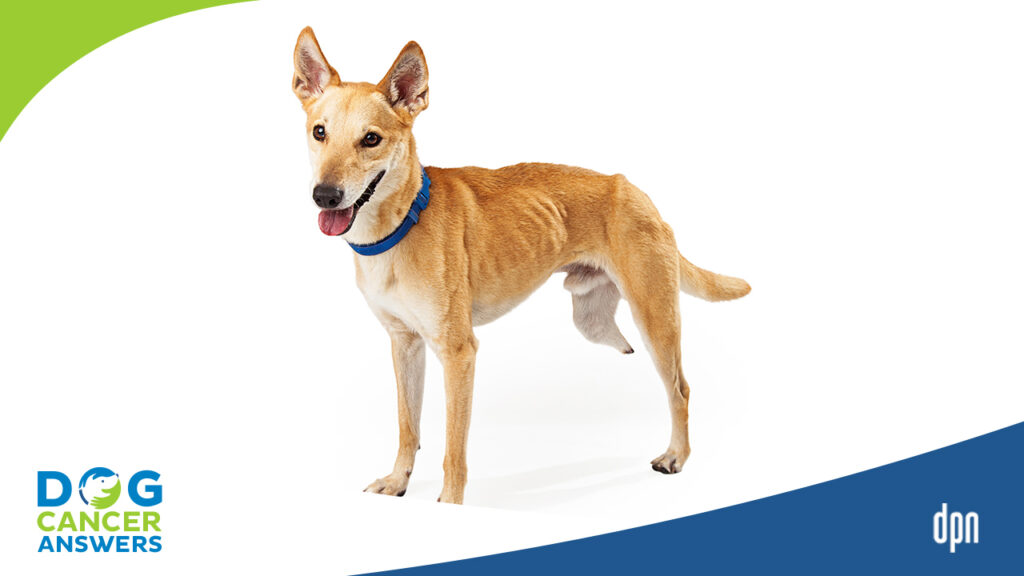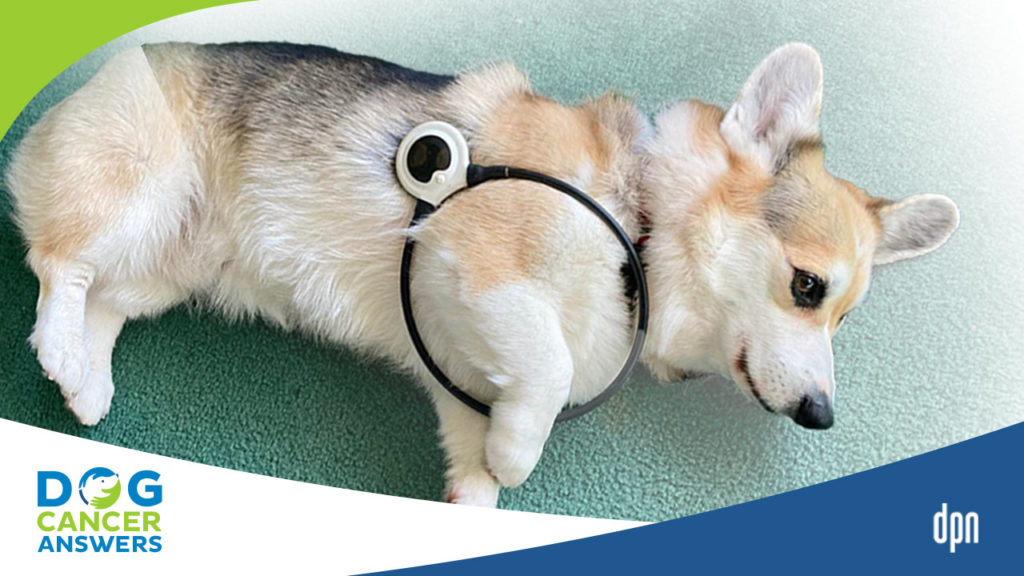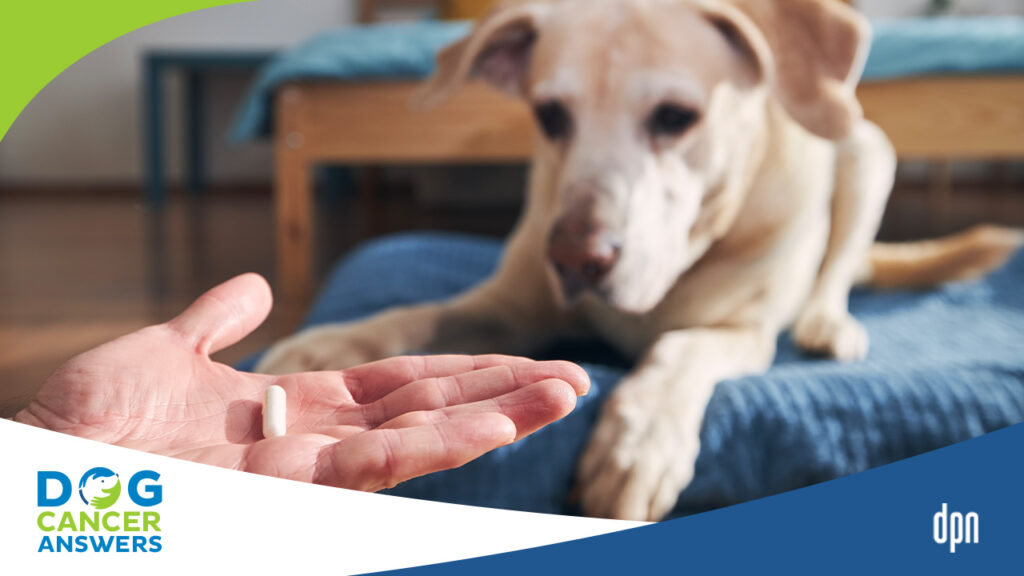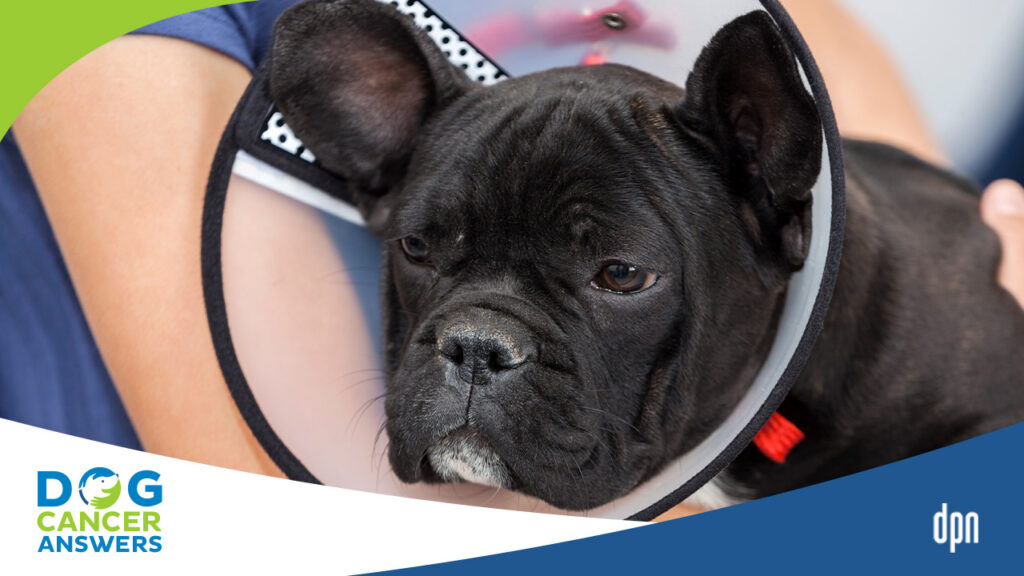EPISODE 73 | RELEASED August 14, 2020
Therapy After Leg Amputation for Dog | Dr. Erica Ancier Deep Dive
My dog has gone through amputation surgery to remove a leg. What happens next? Can mobility therapy help my dog have a good quality of life as a Tripawd?
SHOW NOTES
Cancers that affect our dog’s limbs, like Osteosarcoma, often result in amputation. The aftercare and recovery process can seem daunting, however there are alternative approaches to rehabilitation that can improve your dog’s mobility and ultimately their quality of life. In this episode, Dr. Erica Ancier talks with us about hydrotherapy treatment and other ways you can build strength and stamina in your dog at home.
Links Mentioned in Today’s Show:
Holistic Veterinary Care Website: https://holisticvetcare.com
American Holistic Veterinary Medical Association (AHVMA) Website: https://www.ahvma.org
AHVMA Vet Finder: https://ahvma.org/find-a-holistic-veterinarian
[00:00:00] >> Dr. Erica Ancier: A lot of the dogs, I think it gives them some relief. They’re like, wow, it’s easy to walk in here. If only, you know, my whole house was filled with water, I could get around easier.
[00:00:09] >> Announcer: Welcome to Dog Cancer Answers, where we help you help your dog with cancer. Here’s your host, James Jacobson.
[00:00:17] >> James Jacobson: Hi everyone and welcome to the show. For this week’s episode, we’ll focus on mobility therapies for tripawds, dogs with an amputated limb. But before we get into it, I want to thank our sponsor. The Dog Cancer Survival Guide. This best-selling book is the definitive guide to help you navigate your dog’s cancer journey. It’s available, wherever fine books are sold and also online at DogCancerBook.com.
[00:00:44] Now after making the difficult decision to amputate your dog’s leg, you’re probably wondering what happens next? If you’re interested in more out of the box approaches, you might want to stick around for my chat with Dr. Erica Ancier. We’ll talk about hydrotherapy and how this alternative method can improve the mobility and quality of life for your tripawd.
[00:01:09] Joining us today is Dr. Erica Ancier, who is a veterinary practitioner at Holistic Veterinary Care in Oakland, California, where she specializes in pain control through integrative medicine. She graduated with honors in psychology from UC Santa Barbara and received her doctorate of veterinary medicine from Western University of Health Sciences.
[00:01:29] Her clinical training was focused on rehabilitation and sports medicine for both small animals and horses. Dr. Ancier thank you for being with us today. Welcome to Dog Cancer Answers.
[00:01:41] >> Dr. Erica Ancier: Thank you for having me. I’m excited to be here.
[00:01:43] >> James Jacobson: I’m excited to have you, because when I started looking at your background, the more interested I became, because you’re a relatively freshly minted veterinarian.
[00:01:51] You graduated in 2018, right?
[00:01:53] >> Dr. Erica Ancier: Yes. I graduated a couple of years ago and I kind of went straight into specialty of doing a physical therapy right away.
[00:02:00] >> James Jacobson: And you have a love for horses, as I understand, is that what kind of got you into being a veterinarian? Have you always been into horses?
[00:02:08] >> Dr. Erica Ancier: I have always been into horses. I mean, I think it’s a mix of things I’ve always loved really all animals. I think what got me more into doing more lameness work and stuff with mobility issues was horses because they’re our ultimate athletes. So a lot of the things that we do in physical therapy for small animals and, and frankly, people actually comes from what we first did with horses.
[00:02:30] >> James Jacobson: Well, what percentage of your patients are dogs versus like horses and the rest?
[00:02:35] >> Dr. Erica Ancier: The vast majority are dogs. So here at Holistic Vet Care, I mostly have dog patients. Occasionally I will get a kitty or two, they’re a little bit more difficult to rehab. And then I have like my own side practice where I do some equine acupuncture, laser therapy, things like that on horses.
[00:02:53] >> James Jacobson: What are some of the most common canine mobility issues that you treat at your practice?
[00:02:58] >> Dr. Erica Ancier: Recently, what I mostly will see is one, they have cancer and they also have mobility issues, and they only have so much time left with their family and people just want them to have the best quality of life with the time that they have left.
[00:03:11] So they want them to easily be able to get up off the couch and go for a walk and, you know, maybe have a little energy to play like they used to. We’ll see just general mobility concerns having to do probably more with aging, as well as dogs that are on cancer treatments, such as steroids, that cause muscle loss and even can predispose them to injuries.
[00:03:33] So things like muscle and tendon tears are more likely on steroids and certainly muscle loss. So we’ll frequently see dogs that are on steroids to try to slow that muscle loss, even regain some muscle, improve their core strength so they can ultimately get around more and be more comfortable.
[00:03:50] >> James Jacobson: Do you mainly work by referral then, like as a mobility specialist?
[00:03:55] >> Dr. Erica Ancier: I specialize almost exclusively in the physical therapy component, you know, as well as pain management. But oftentimes they’re working with an oncologist if they have cancer and they’re treating it or they’re at least monitoring it. And then I work on things that are, you know, harmless, might help quality of life and improve mobility.
[00:04:14] So sometimes I’m seeing patients, for example, common one is osteosarcoma or bone cancer. The dog has to get the leg removed and now they’re on three legs. They’re older. They likely already have arthritis and maybe some spinal issues. And so just teaching them to walk again on three legs is quite a challenge. And so I often see dogs after that’s removed or even a mass removal.
[00:04:37] >> James Jacobson: Let’s explore the osteosarcoma for a moment, because my understanding is that most dogs after they have one of their legs amputated, tended to fare pretty well.
[00:04:45] >> Dr. Erica Ancier: I think that maybe a young dog gets a leg removed and you don’t see as many issues until they get older. But an older dog, taking away one of its legs, it’s pretty substantial actually.
[00:04:56] >> James Jacobson: But you do something for them. Is that on the pain management side or is that on, on what side?
[00:05:02] >> Dr. Erica Ancier: Mobility. I mean, we will just work on stabilizing their core to support themselves. We work a lot on turns because dogs, especially if they have a front limb removed, they have difficulty turning.
[00:05:13] We work on getting up and getting down comfortably. So we just do exercises as simple as sit to stands, which are basically like squats in people. Down and sit, you help them get back up. They might do that occasionally throughout the day. But if you do it as an exercise, maybe five of those in a row, then they are actually building up strength and stamina and it’s easier for them when they want to get up.
[00:05:34] >> James Jacobson: And how many sessions would you work with a dog that recently had a surgery to remove one of its legs?
[00:05:40] >> Dr. Erica Ancier: It really depends, you know, if that dog had a leg removed and it had pretty good mobility beforehand, it might just need to come in once a week, six weeks check back in, it’s doing well. I give them some home exercises to follow up with and they maintain mobility versus dog that already had arthritis, spinal issues, if it’s more what I see because they’re older and most older dogs have those conditions and they have mobility issues to start with. So some of those we’re seeing really frequently both for rehab and acupuncture in order to manage pain, improve mobility.
[00:06:12] >> James Jacobson: So tell me a little bit about the hydrotherapy that you do with these tripawds?
[00:06:16] >> Dr. Erica Ancier: We will often use the underwater treadmill with a lot of our patients and that’s beautiful because it takes weight off of their joints. It adds some buoyancy, it, adds some resistance and they get to build up strength in a lower impact environment. And some of the dogs too, let’s say they had their front limb removed.
[00:06:32] They have one left. It’s so overloaded and painful and sore, and it’s doing so much of the work that will put them in the underwater treadmill, we’ll actually isolate the hind leg. So we’ll put the front leg on a stationary object and then let them just walk normally with their hind legs instead of hopping along. And that can be really, really nice strength building and just kind of a nice break for them.
[00:06:53] >> James Jacobson: So paint a picture for me, cause I’ve never seen one of these.
[00:06:56] >> Dr. Erica Ancier: Okay. So it’s a box that fills up with water and it has a treadmill in it. And usually we’ll have an assistant go in there with the dog at first and get them used to it because it’s kind of scary.
[00:07:08] You know, it’s almost like a escape room type thing the first time a dog goes in there. They go in, it closes, it seals, it slowly fills with water. They have no idea that we’re going to stop that water at one point and not drown them. And so they’re scared at first. So, you know, if they’re willing to take treats and love, we give it to them. Some of them just freeze a little bit until they know what’s going on.
[00:07:26] >> James Jacobson: It’s not enclosed on the top. Is it?
[00:07:28] >> Dr. Erica Ancier: Not on the top, but it’s enclosed on the sides and it has a door that opens.
[00:07:31] >> James Jacobson: Okay.
[00:07:31] >> Dr. Erica Ancier: So once they go in, then it closes and then they’re stuck in there and it’s a little bit scary. And again, filling up the water slowly. It’s 90 degree water. It’s, you know, it’s nice water, but, um, still they’re a little bit scared. And then depending on the patient, what we want to isolate, how much support they need of the water, we’ll put the water at different levels. So if a dog is having some knee issues, we’re gonna put the water level right in its knee joint so that they have to break through the surface tension of the water as they’re moving. And that will add to increased range of motion in that joint and strengthen all the tissue around it. And oftentimes we’ll stick a little, uh, like a peanut butter stick on in the front of the treadmill. The dog is happily sitting there, licking peanut butter and walking and not thinking much out of it.
[00:08:15] >> James Jacobson: That’s the incentive. So treadmill, I guess you can control the speed of that as well.
[00:08:19] >> Dr. Erica Ancier: Exactly. So we can go really slow for a small dog or a dog with a lot of mobility issues, or if we’re trying to work on fitness, we can make them jog, make them run in there.
[00:08:30] >> James Jacobson: Is there anything in the water or is it just plain 90 degrees?
[00:08:33] >> Dr. Erica Ancier: It’s chlorine.
[00:08:34] >> James Jacobson: Chlorine. Okay. And how many sessions in the pool would an average dog that you’re treating, you know, as a tripawd, go through?
[00:08:42] >> Dr. Erica Ancier: I usually will do once or twice a week rehab for like six to eight weeks, do a recheck and add that recheck. I’m looking at muscle mass, mobility at home, you know, pain management, just how they’re doing overall, their balance.
[00:08:55] And then from that we determine, so oftentimes these dogs that are older with cancer, arthritis, multiple issues, and now they lost a leg, they might have maintenance for the rest of their lives, but maybe at first we’re once, twice a week, then we space it out. We see them every other week. Sometimes they say, okay, they’re doing well at home.
[00:09:12] They have good mobility. Then we let them graduate. Otherwise we continue some kind of maintenance program. A lot of people do want that because they just see how much their dog improves. And, you know, it’s hard to get that effect at home. There is something pretty magical about the underwater treadmill.
[00:09:29] >> James Jacobson: Do they tend to like it after they overcome it, they get the peanut butter treat, but I imagine after awhile they kind of enjoy it?
[00:09:34] >> Dr. Erica Ancier: Yeah, a lot of the dogs, I think it gives them some relief. They’re like, wow, it’s easy to walk in here. If only, you know, my whole house was filled with water, I could get around easier. One dog, had a front limb removed.
[00:09:45] It had a spinal issue in its neck. That is a problem. It’s, you know, it was already wobbly. It had severe arthritis already and it got the leg removed. It fell once and never walked again for the owners would not get up. They thought it was a spinal issue. They said, put the dog down .It must’ve had a disrupture, it’s an aggressive type of cancer.
[00:10:04] Just go ahead and put it down. And I did my exam and they were like, do you think it can walk again? And I was like, I don’t know. But things I found in my exam just gave me the hunch that the dog could walk. It just either was too painful or choosing not to because it got scared. And so now it walks again, walks a little funny.
[00:10:20] First time it stood was standing up in the underwater treadmill. Everybody in the gym had tears in their eyes and then it was able to get around their yard and, you know, play ball. It chased the mailman.
[00:10:32] >> James Jacobson: Well, that’s definitely a big shift from not getting up at all to chasing the mailman. In the case of that dog, where the guardians with you during this rehab process, or do you just like, you know, take him into the mysterious back?
[00:10:44] >> Dr. Erica Ancier: They’re typically there for the whole process and their interaction is integral to the dog getting better. So, even that dog came in three times a week. It was pretty extensive. But even then they need to do home exercises. They need to do stretching, massage, maybe some ice, in order to get the dog better, stronger, more balanced, less painful. So that’s really important. And then in rehab, it’s great to have them encouraging the dog there with them.
[00:11:08] >> James Jacobson: I can imagine so. Okay. This is a great place to take a short break, but when we return, let’s talk about continuing that mobility therapy at home and your thoughts on laser treatment.
[00:11:22] Today’s episode of Dog Cancer Answers is brought to you by the best-selling animal health book, The Dog Cancer Survival Guide: Full Spectrum Treatments to Optimize Your Dog’s Life Quality and Longevity by Dr. Demian Dressler and Dr. Susan Ettinger, an oncologist in New York. And in a minute, I will tell you how to get their book at a discount. We hope that our discussion about hydrotherapy is showing you that there are ways that you can help increase your dog’s mobility and improve their quality of life after cancer surgery.
[00:11:54] I found that reducing pain is an important part of cancer treatment. And there are so many things that you can do for your dog after you get that dreaded cancer diagnosis. Drs. Dressler, and Ettinger wrote The Dog Cancer Survival Guide with exactly this in mind. They want you to have the best tools at your disposal for fighting your dog’s cancer.
[00:12:15] They cover the five big steps of cancer care, conventional treatments, nutraceuticals, supplements, diet, and mind, body and life quality strategies that you can do at home that are fun for your dog. You know, as a dad, to a dog with cancer, I can tell you that having this book on my shelf for reference is invaluable.
[00:12:36] The Dog Cancer Survival Guide is available wherever fine books are sold, both online and in physical bookstores. And you can support this podcast by using a coupon code and getting the The Dog Cancer Survival Guide right away, direct from the publisher. It’s available either in paperback, with free shipping anywhere in the US, or as an e-book edition.
[00:12:56] And the e-book is under $10. The website to get either the paperback or the e-book is www.DogCancerBook.com, and you will save 10% if you use the promo code PODCAST when you checkout, you’ll save 10%. The website again, DogCancerBook.com. You use that promo code PODCAST for 10% off. That is www.dogcancerbook.com.
[00:13:24] And we’re back with Dr. Erica Ancier. Let me ask you, does therapy continue at home? Is that an important piece of the recovery for these tripawds?
[00:13:34] >> Dr. Erica Ancier: Yeah. Really for any dog, especially, you know, let’s say the dogs only coming in once a week, twice a week. I always tell people, like, if you were to go to the gym once or twice a week might help a little, but it’s not going to make that much of a difference. Like you need consistency. So on all the days that they’re not here, they’re doing a regular exercise routine with them. I try to keep it simple, you know, lifting up a leg. They have to balance on the other legs, doing some figure eights so that they’re more balanced, then they work on turns. I also have to read the family, like how committed are they?
[00:14:04] How much time do they have, you know, did they just have a new baby two weeks ago? Or are they not really going to do anything at home? It depends on the family, but a lot of people, especially that come to us fortunately, are very committed to getting their animal better, you know, maybe they don’t come in as often for financial reasons.
[00:14:19] So they want to make it work by being very consistent at home. And I’m very clear with them. Like if you don’t do the work at home, your dog, isn’t really going to get that much better.
[00:14:28] >> James Jacobson: Along those lines, can people do hydrotherapy treatment at home? Obviously you can’t put a treadmill inside of a bathtub, but just using a bath tub, would that be helpful?
[00:14:37] >> Dr. Erica Ancier: Bath tubs can be a little bit slippery, but it’s possible if you put a mat under there and you just fill it to a certain water level and you let the dog walk around, it’s a little small.
[00:14:45] I have had some people use kiddie pools. You fill it up and I would say average dog, if you just want to give them some support, walking around, I’ll put it right at their kind of limb fold, right at the top of their hind legs.
[00:14:55] >> James Jacobson: Are there other mobility things that you use, like do you use cold laser therapy?
[00:15:00] >> Dr. Erica Ancier: We do use cold laser. It’s a interesting tool when it comes to cancer because it’s kind of controversial.
[00:15:05] >> James Jacobson: How so?
[00:15:06] >> Dr. Erica Ancier: So laser in general, it increases blood flow, it increases energy to the cells that you’re lasering over. So you don’t really want to do that directly over cancer because essentially you would be feeding the cancer. You don’t want to provide it any more blood supply or energy than it already has, unless it’s deep in the body, but some people take that and they say, I’m not going to laser any animal with cancer, because I don’t want to, at all, exacerbate, what’s already going on.
[00:15:33] >> James Jacobson: How would you discuss laser therapy with your clients who might be, you know, a little skeptical as they navigate the best treatment?
[00:15:40] >> Dr. Erica Ancier: I always have the conversation with a client that their patient has cancer. That lasering area that is not involved in the cancer is likely safe, but there is, I’m sure some risk involved.
[00:15:50] There’s only so much that we know at this point. I think you have to think quality and quantity, meaning quality in their time that they have here versus I want them to live forever and, you know, be completely immobile. A lot of people will choose to laser anyways, especially if it’s not in that same region. There are some cancers that can be kind of dispersed and that becomes a conversation. Sometimes I’ll have people consult with their oncologist to get a recommendation on it and see how they feel.
[00:16:17] >> James Jacobson: We have listeners obviously, who are grappling with dog cancer and they may be going to their vet who they’ve been going to for years as it was just a puppy and now it’s more senior dog that has a cancer problem. And they’re looking for, sometimes, outside the box approaches from a veterinarian. Is that something that you could provide some guidance to our listeners about?
[00:16:40] >> Dr. Erica Ancier: Yeah. So, I mean, you’re ultimately the advocate for your own animal. And so, you know, if you’re seeing that your older dog has cancer and they’re also having some mobility issues, they’re losing muscle, I think it’s the owner’s right to seek out the care that they need for them. So even in all parts of the country, there really are physical therapy facilities. There’s acupuncturists. There’s people that offer these alternative modalities. You might have to try it a little bit, but they are certainly available if you seek them out.
[00:17:10] In fact through the AHVMA website, the Holistic Vet website, that’s a good way to find a veterinary in your area that offers some of those modalities.
[00:17:19] >> James Jacobson: Thank you so much, Dr. Erica Ancier. I appreciate you being with us today. That’s really interesting information to help dogs that have had a leg removed, uh, you can help them regain their mobility.
[00:17:28] >> Dr. Erica Ancier: My pleasure. Thank you so much for having me.
[00:17:32] >> James Jacobson: Today’s conversation is another example of the amazing adaptability and resilience of dogs. A lot of people think that amputating a dog’s leg is the worst thing you can do, because the thought is that our dogs will never recover. But actually, with time encouragement and therapy, dogs can recover beautifully and even chase mailmen again. I was fascinated to learn that hydrotherapy treatment can continue at home. And while a bath tub may be tricky, using a kiddie pool can really help with recovering. But most importantly, our continued support will make all the difference in the world. Mobility therapy will only be as successful as we, the dog lovers, allow it to be because rehabilitation takes work from the whole family, not only during a visit to the vet, but also at home.
[00:18:26] Those touchstones remind me to remind you that our veterinarians are on-call at our listener line. If you have a question for a dog cancer vet, please call our listener line and record your question. We’ll pose it to one of our veterinary experts and your question and the answer will appear on a future episode of Dog Cancer Answers.
[00:18:49] The telephone number to record is (808) 868-3200. That is a 24 hour a day line so you can call any day or night, (808) 868-3200, or of course you can submit your question on our website at DogCancerAnswers.com. Also, if you like our show, please rate us on Apple Podcasts or Spotify or wherever you listen. Share us on social media, we’re on Instagram, Facebook and YouTube. Please help spread the word about this podcast because we want to help as many dog lovers as possible. And your likes and shares and ratings really help keep us motivated. Also, if you want to reach out to us, visit us on our website, where we have tons of additional information to help you navigate your dog cancer journey. The website is DogCancerAnswers.com.
[00:19:44] Let’s take a brief moment to thank our sponsor. The Dog Cancer Survival Guide book by Dr. Demian Dressler and Dr. Sue Ettinger. The book is available, wherever fine books are sold, both online and in physical bookstores. And remember if you’d like to help support this show, get the book directly from the publisher, Maui Media. The website, DogCancerBook.com and use that promo code PODCAST, and you can save 10% off. That is www.DogCancerBook.com.
[00:20:16] And finally, I’d like to thank our guest today, Dr. Erica Ancier, you can reach her at her website. Until next time. I’m James Jacobson from all of us here at Dog Cancer Answers and Dog Podcast Network, we wish you and your dog, a warm, Aloha.
[00:20:37] >> Announcer: Thank you for listening to Dog Cancer Answers. If you’d like to connect, please visit our website at DogCancerAnswers.com, or call our listener line at (808) 868-3200. And here’s a friendly reminder that you probably already know, this podcast is provided for informational and educational purposes only. It’s not meant to take the place of the advice you receive from your dog’s veterinarian.
[00:21:00] Only veterinarians who examine your dog can give you veterinary advice or diagnose your dog’s medical condition. Your reliance on the information you hear on this podcast is solely at your own risk. If your dog has a specific health problem, contact your veterinarian. Also, please keep in mind that veterinary information can change rapidly, therefore, some information may be out of date. Dog Cancer Answers is a presentation of Maui Media in association with Dog Podcast Network.
Hosted By
SUBSCRIBE ON YOUR FAVORITE PLATFORM
Topics
Editor's Picks
CATEGORY

